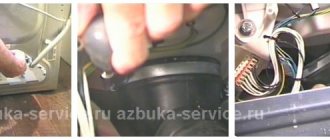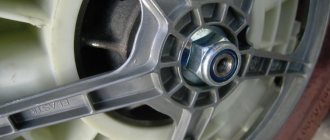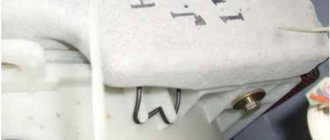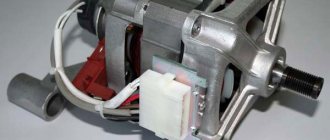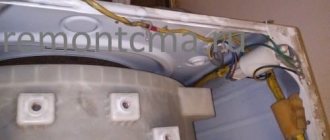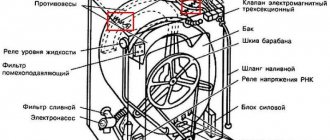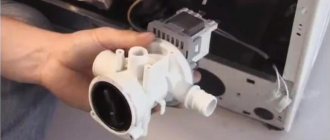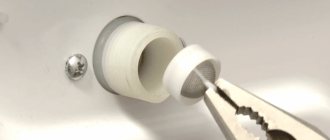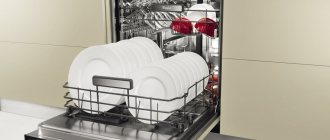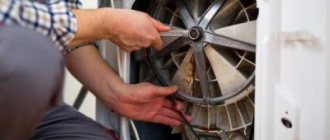- How to diagnose that your washing machine bearings are worn out
- What problems can arise if bearings are not changed in time?
- Steps to take when replacing a front-loading washing machine bearing yourself
- Replacing a bearing when repairing a top-loading washing machine
- The nuances of performing work on machines from different manufacturers
- How much does it cost to replace bearings in a washing machine - price review
- Video: Replacing bearings in a washing machine with a cast tub
How to diagnose that your washing machine bearings are worn out
The most typical signs that a washing machine bearing has failed, or will happen in the near future, are:
- when the washing mode is turned on, the machine operates, emitting a characteristic hum, but the drum does not spin;
- the washing mode started, but during operation there was an unusual noise made when the drum rotated, and vibration uncharacteristic of normal operation;
- The laundry spin mode does not work, it remains damp (does not spin);
- the drive belt quickly fails (wears out);
- When loading laundry, you feel the drum swaying on the rotation axis.
How to replace a bearing in a Zanussi washing machine
Despite the fairly high reliability of Zanussi household machines, the drum ball bearings need to be replaced periodically, especially during intensive use with maximum load. In modern modifications, error code E13 or E55 is displayed on electronic displays, which are issued by the self-diagnosis system. This indicates a possible oil seal leakage, play or wear of the seal. A characteristic feature is also the sound that appears during the spin cycle.
In order to dismantle and replace parts, you will need to disassemble the machine. Unlike other models, there is no need to remove the front panel; just unscrew the back cover to gain access.
After sequential disassembly of the unit and removal of the tank, using a special puller or improvised means, the elements are knocked out, the seats are cleaned, the belt, crosspiece, drum geometry and serviceability of other parts are checked. To facilitate dismantling, it is advisable to use WD-40 aerosol.
If the machine is under warranty, all repairs should be carried out only at a service center.
You can find the answer to the question: how to replace bearings in an automatic washing machine yourself: Veko, Bosch, Ariston, Lg, Ardo and other popular models by studying in detail videos on the Internet and step-by-step instructions. And to purchase the necessary parts for the bearing assembly, use the catalog of bearings for washing machines https://podshipnik.mobi/catalog/bearings/podshipniki-dlya-prochey-tehniki/podshipnik-dlya-stiralnoy-mashiny
What problems can arise if bearings are not changed in time?
Bearing failure is always an unpleasant event, because... replacing it is a rather complicated undertaking, but nevertheless necessary. This is due to the fact that failure to perform this operation can lead to negative consequences of varying severity:
- the bearing seat will break, which will require replacing the entire drum;
- the electric motor will burn out, which will require major repairs or replacement;
- if there is a belt drive, the belt installed between the engine and the drum shaft may break;
- other components that ensure the transmission of the rotational motion of the electric motor shaft to the drum of the washing machine, available in the design of the model (crosspiece, pulley, etc.), may be damaged;
- The integrity of the tank may be damaged, especially for models where this structural element is made of plastic, which, in turn, will lead to water leakage and, as a result, flooding of neighbors and damage to the electronic control system.
Drum bearing: the weak point of the washing machine
A washing machine is a rather complex household appliance and it operates under high loads. The most vulnerable point of this home worker is the drum bearing - the part thanks to which the washing process in the machine actually takes place. It is very easy to understand that the time has come to change it: if there is a faulty bearing, the unit begins to emit extraneous sounds during operation, which, if nothing is done, intensify over time.
Offers a large selection of high-quality bearing products - https://termopolis.com.ua/
But this is not the most unpleasant thing. If the bearing fails, the drum stops working normally. And this means that very soon the washing machine will completely break down, and you will have to pay quite a lot of money for its overhaul.
The average service life of a quality drum bearing is 6-8 years. However, due to improper operation of the machine, destruction of the oil seal, corrosion due to leakage, etc. it breaks much faster. That is why the unit should not be overloaded: in most cases, the causes of bearing failure are increased friction intensity and, as a consequence, excessive heating of the structural elements of the part.
If you decide to replace the drum bearing yourself, you will have to do this together with the oil seal. You can buy them in a store or on the market, carefully monitoring the quality of the parts and their compliance with the model of your washing machine.
Steps to take when replacing a front-loading washing machine bearing yourself
As already written above, replacing a bearing is a rather complex task, for which it is necessary to disassemble the washing machine. To do this you will need the following tools:
- hammer;
- rubber (plastic) mallet;
- pliers;
- Screwdriver Set;
- set of wrenches;
- gas key.
In addition, you must have silicone sealant, WD-40 aerosol, as well as appropriately sized bearings and seals, as well as lithol or another type of similar lubricant.
For your information!
If the user is performing such work for the first time, then in order to facilitate the assembly process and avoid mistakes, you can use a smartphone and film all types of connections of various components and electrical connections before starting the disassembly process.
The work of replacing the bearing on different models of washing machines may vary slightly, but, nevertheless, the main steps are performed in the following sequence:
| Illustration | Description of action |
| The back cover is unscrewed. | |
| The drum shaft drive belt is removed. | |
| The rotation of the drum is jammed; for this, use a screwdriver or other durable tool. | |
| The nut securing the pulley is unscrewed and it is removed. | |
| The wires from the heating elements and other elements of the electrical circuit are disconnected. | |
| The elements securing the drum to the machine body and the electric motor are unscrewed. | |
| The top cover of the washing machine is unscrewed and removed. | |
| The structural elements located in the upper part of the housing are disconnected, preventing the drum from being removed. | |
| The drum is removed from the machine body. | |
| Using a screwdriver, remove the oil seal. | |
| Using a hammer and punch, first knock out the inner bearing. | |
| Then the outer bearing is removed in the same way. | |
| The seat is cleared of dirt, and the new bearing is pressed in using a mallet or a wooden block and a hammer. |
In order to knock out the bearing, you can use a core and a hammer, as in the case discussed above, or special pullers, if available.
Important!
When knocking out a bearing, it is necessary to strike along its entire circumference, otherwise the bearing may become crooked and jam, which will lead to unnecessary problems associated with its removal.
To make it easier to install the new bearing into the seat, it can be lubricated with grease or another type of thick lubricant. When installing a bearing located inside the drum body, you can use a hammer handle or a specially made piece of wood that matches the diameter of the seat. WD-40 aerosol will be required if any fastening elements will not be unscrewed, then they should be treated with this preparation. The washing machine is assembled in the reverse order to how it was disassembled. After completion, the functionality of the repaired household appliance is checked.
Replacing a bearing in a front-loading washing machine
The element is replaced in accordance with the manufacturer's recommendations or when abnormal noise, squeaking, vibration or leakage occurs. You can change parts yourself only if you strictly follow the instructions, have the tools and experience, since you have to disassemble almost the entire washing machine, regardless of the manufacturer, in order to get to the tank and remove the drum. Traditionally, front-loading models have 2 elements installed, which are not maintained, are replaced, and are subsequently disposed of.
The presence of a puller will greatly simplify all activities; if you do not have the device, use a copper hammer and chisel. Impacts should be applied to the upper cage carefully enough to avoid distortion, deformation of the seats and damage to other components.
After dismantling, you should thoroughly clean oxidation, dirt, and check other components for functionality.
Replacing a bearing when repairing a top-loading washing machine
A distinctive feature of top-loading washing machines is that the drum is attached to the body on two axle shafts, and not on one, as in the models discussed earlier. In this case, the bearings are changed on both axle shafts at the same time, regardless of which one has failed. Work on units of this type is carried out as follows:
- The outer and rear walls of the machine are removed.
- Electrical wires and hoses that could interfere with work are disconnected.
- The linings located on the sides of the drum, under which the calipers are located, with the bearings installed in them, are removed.
- The bearing on the side where there is no pulley is changed first, then on the opposite side.
- The seats are cleaned and lubricated before installing a new bearing.
- The units are assembled in the reverse order of disassembly.
Important!
On the side where there is no pulley, the thread securing the caliper is normal, right-handed, and on the side where the pulley is installed, it is left-handed.
Causes of bearing failure
Physical wear of bearings usually occurs after 5-6 years of active use. If the parts failed before this period, the reasons for this could be:
- constant overload of the unit with laundry whose weight exceeds the permissible limit;
- the user does not take measures to eliminate problems that arise;
- factory defect;
- untimely repair of parts due to their natural wear.
So, we have provided you with detailed step-by-step instructions for replacing a bearing in a washing machine. To prevent further damage and leaks, you must perform each step carefully and avoid damaging parts.
The nuances of performing work on machines from different manufacturers
To repair some models from individual manufacturers, you need to know about the nuances determined by the design of these units. Washing machines of such brands as Indesit and LG, Samsung and Atlant have such features.
"Indesit" (Italy)
When repairing cars of this brand, it is initially necessary to clarify the design of the tank, because it may be different. New models are produced with a non-separable tank, and older ones with a collapsible one.
This determines the volume and sequence of operations performed. In addition, on some models the pulley mounting screws may have left-hand threads (W 84 TX), which must be taken into account.
If the brass bushing installed on the axis of the drum cross is damaged, it must also be replaced when performing such work. Also, models of this brand provide for double fastening of the drum axis, which is a certain nuance that should be remembered. The presence of a self-positioning sensor, which must be turned off when dismantling the drum, is another feature that you should know when doing the work yourself.
"LG" (South Korea)
For washing machines from this manufacturer, the tank is removed from the front of the device body. Modern models of this brand have improved technical characteristics that allow you to wash a significant amount of laundry in one load. In this connection, such devices are equipped with a tank that is significant in weight, which somewhat complicates the performance of the described work. In addition, when disassembling the drum, you should pay attention to the mounting unit for the electric motor, which is somewhat different from the type of mounting used by other manufacturers.
Samsung (South Korea)
The design of washing machines of this brand also involves dismantling the tank through the outer wall. When working with Samsung washing machines, you should be especially careful when knocking out the bearing, because If the bushing is damaged, the entire drum will have to be replaced. In addition, a distinctive feature of this brand is the use of two bearings of different sizes on one shaft. In this case, the larger one is knocked out from the outside towards the tank, and the smaller one from the inside.
"Atlant" (Belarus)
For machines of this brand, the drum is removed from the rear side, which is provided for by their design. The tank on Atlant brand machines is of a collapsible type, so there is no need to saw it when replacing bearings.
When assembling the tank, it is necessary to use a sealant, this will provide more reliable protection against leakage.
How to properly prepare for work
First you need to drain the remaining water from the washing machine, as you will need to completely disassemble it. Proceed sequentially:
- De-energize the SM by removing the plug from the socket.
- After disconnecting all communications and shutting off the water supply, drain the remaining water from the intake hose.
- Do the same with the drain filter. It is located under the front panel, behind a small hatch or plinth panel. Open the panel by releasing the latches with a screwdriver, unscrew the filter, and drain the water.
Move the machine away from the wall as far as possible. Now prepare a tool to remove the washing machine bearings. You will need:
- a set of slotted and Phillips screwdrivers, possibly hexagonal;
- a set of wrenches and socket wrenches;
- pliers;
- puller;
- hammer and chisel;
- bolt;
- sealant;
- hacksaw for metal.
Before purchasing a puller, make sure the bearing needs replacement. Then purchase a universal puller suitable for dismantling elements of any size.
Buy a new part. This can be a wheel bearing or any other that is suitable for your model. You can find out the exact numbers and markings after you remove the bearing from the washing machine.
How much does it cost to replace bearings in a washing machine - price review
The cost of repairs associated with replacing bearings depends on a number of factors:
- region and location of the service center or repair shop;
- manufacturer's brand;
- features of a specific model, if any;
- availability of a warranty period after repairs are completed;
- urgency of work.
On average, the work of replacing bearings, performed by professional craftsmen, takes from one to three hours, which depends on the model of the washing machine and the design of the tank (collapsible/non-dismountable). The cost of replacing a bearing in a washing machine in different regions of our country is:
- in Moscow – from 1,000 rubles;
- in St. Petersburg – from 1,100 rubles;
- in Krasnodar – from 1,800 rubles;
- in Vorkuta – from 1,800 rubles;
- in Novosibirsk – from 2,000 rubles.
Although the work associated with replacing a bearing is quite complex. However, many users try to do it themselves; fortunately, you can find many stories on the Internet that tell you how to do it correctly. One such video is shown below.
Some details of replacing the bearing in the Atlant washing machine
Belarusian cars occupy a worthy place among budget models, featuring a fairly high degree of reliability. The main problem encountered is the periodic need to replace bearings due to wear. The main signs indicating the need for repair are a characteristic hum that occurs when the spin cycle is turned on, vibration and other extraneous sounds. You can verify the need for maintenance by opening the loading door slightly, rocking the drum, and then turning it. If there is play and uneven rotation, it is necessary to remove the worn-out bearings and replace them. Otherwise, more expensive repairs may be required.
You can order the required elements by modifying the unit on the Internet or from the supplier. Korean parts, which are more wear-resistant, are also suitable.
As with other front-loading machine repairs, complete disassembly is required to remove the tank. You should turn off all networks and hoses, unscrew the filter and drain the remaining water, and install the equipment on a level surface. Then sequentially disconnect the panels, covers, electrical wiring, pull out the detergent tray, motor and weights. To unscrew the pulley, you can use a wooden block to jam it.
Having pulled out the tank, you need to lay it on the floor, unscrew the screws and divide it into two halves, remove the drum and begin replacing the seal and seal. This modification has one element located in the tank opening.
The part is knocked out quite easily, by systematically tapping with a chisel along the contour of the outer casing. After dismantling, you should thoroughly clean the mounting hole and check the safety and functionality of other elements. The drive belt may need to be replaced.
Smoke
The smell of smoke, burning rubber or insulation is also a sign of a broken bearing.
It occurs for several reasons:
- The assembly or oil seal itself stinks due to increased friction when the drum rotates;
- The drive belt smokes as it slips on the pulley due to increased resistance;
- The insulation and engine parts begin to melt due to the increased load.
Of course, the washing machine should be stopped immediately, otherwise a fire is not far away. In addition, depressurization of the tank can lead to a short circuit and electric shock. Because in a significant part of apartments such household appliances are not grounded at all.
How can you tell if a part is broken?
It is quite difficult for the user to identify a malfunction at an early stage. The more wear on the bearings, the more obvious the “symptoms” of failure will become. The following signs will indicate that the bearing assembly has failed:
- noise and grinding noise when the drum rotates. Washing and spinning may be accompanied by clanging and crunching. The more revolutions the engine gains, the louder the sounds produced by the equipment become;
- bad spin. Due to the destruction of the bearings, the motor cannot operate at full power, so the things in the drum remain too wet;
- increased vibration. Due to the imbalance of the drum, the machine literally “jumps” during operation;
- hatch cuff defect. When the drum begins to play, its edges wear out the rubber seal.
If you notice one of the signs of malfunction, it is better to check the condition of the bearing assembly. If diagnostics confirm the problem, you need to immediately replace the components. You can entrust the repair to a specialist or, if desired, try to do it yourself.
Interesting:
- How to change the seal on a washing machine?
- Replacing the oil seal on a Zanussi washing machine
- Indesit washing machine is leaking
- How to change the seal of a Bosch washing machine?
- How to change bearings and seal on an LG washing machine?
- The drum in the washing machine came off
Reader comments
- Share your opinion - leave a comment
